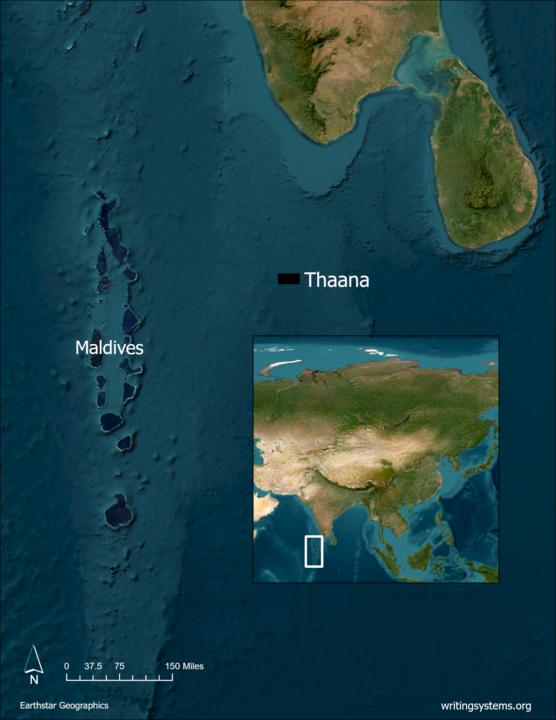“The Thaana script is used for writing the Maldivian language, also known as Dhivehi, spoken by about 370,000 people in the Maldives and in Maldivian communities in India. The script is unique to this language. The language is also called Mahl, particularly on the island of Minicoy in the Indian territory of Lakshadweep. The Maldivian language has been written in its own script, it is thought, for over two millennia, when it was developed by Maldivian Buddhist monks translating the Buddhist scriptures.
The Thaana script is broadly considered an alphabet as all vowels are written, although it also contains characteristics of an abugida, for example the use of a vowel-killer symbol to indicate a consonant with no following vowel. It is one of the few alphabets in the world which does not have its roots in the Proto-Canaanite script. Rather, the first nine letters are derived from the shapes of the numerals used in Arabic writing, and the next nine from earlier forms of Maldivian letters.
The alphabet comprises two main types of signs. The twenty-four consonant letters, including a “null consonant” alifu form the base line of writing. These do not contain an inherent vowel, unlike many of the Indic scripts. All vowels are written explicitly using ten diacritics, called fili. Where a consonant is not followed by a vowel (for example as part of a consonant cluster or at the end of a word) this must be indicated using the “null vowel” symbol, sukun. Spoken Maldivian also employs a series of intervocalic prenasalized stops; these are written using the letter nūnu, without any diacritic, before the stop.
All diacritics are written above the base consonant, with the exception of the vowels i and ī, which are written below it. Spoken vowels may be either long or short. In writing, long vowels are represented using doubled versions of the short vowel sign, although the doubled sign only takes up the space of a single vowel sign. (The exception to this is the long ō which is written with a diacritic unrelated to the short o.) In the case of diphthongs, the second part of a diphthong is written on a null consonant (“alifu”) sign. There are no independent vowel letters for representing word-initial vowels; instead, the vowel diacritic is written above the consonant alifu, which is phonetically null. Alifu is also used word-finally with the sukun diacritic to indicate a glottal stop. The sukun diacritic is also used with the letter nunu to indicate long nasals.
In addition to the consonant and vowel letters that make up the standard Thaana alphabet, there is a set of extra letters, known as thiki jehi Thaana (“dotted Thaana”). These letters use one or three additional dots above or below a Thaana letter to transcribe the Perso-Arabic script, for example when writing loan words. However, many established loans also have alternate nativized spellings without dotted letters. (Note that although the paviyani letter has a dot it is part of the basic Thaana script, not the dotted series.)
Aspiration is not distinctive in Maldivian; neither is it written in Thaana. The official Maldive Republic romanization system uses the Latin letter h to distinguish between a dental and a retroflex stop, not to indicate aspiration as it is used in some other transcription systems. This system also uses h word-finally to indicate a glottal.
The canonical order for Thaana letters is seemingly arbitrary. It does not follow either the Arabic or the Brahmic order.
Inter-word spacing was not traditionally used in Thaana but is generally used in modern texts.
Thaana does not use a script-specific set of digits. Either Latin numerals or the numerals used in Arabic writing can be used.“ ScriptSource Staff, Retrieved June 14, 2023


